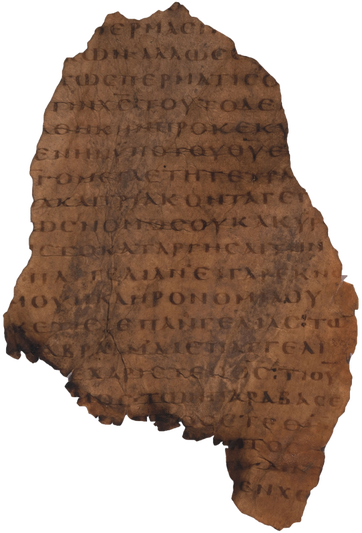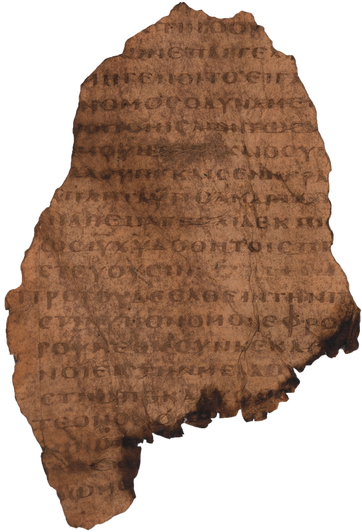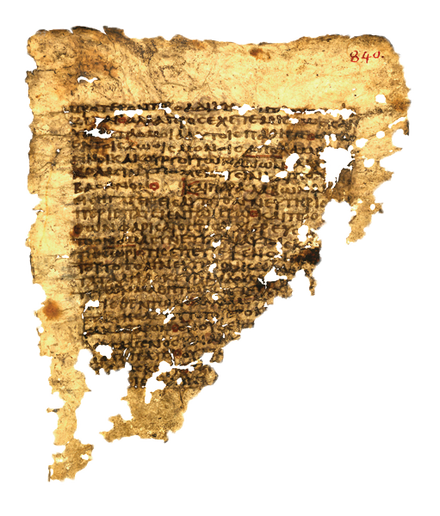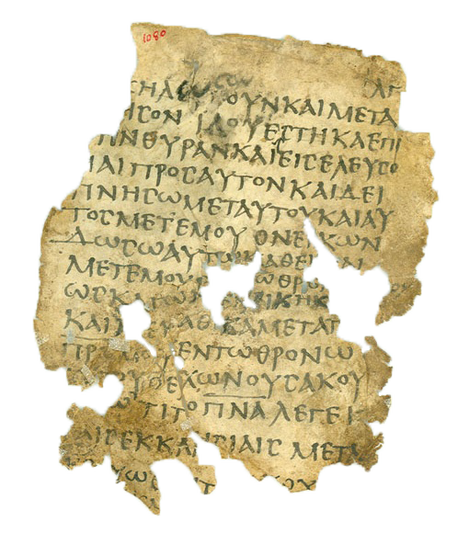PSI 3.251 (NA 0176; LDAB 3032)
This is a fifth century Greek parchment fragment containing portions of Galatians 3. This is a beautiful specimen in terms of the quality of the parchment and the elegance of its script. It once belonged to a beautiful miniature codex, perhaps containing the entire New Testament. Notice the wide spacing in between letters, the lining of the parchment, and the positioning of the letter π into the left margin in the right image (a phenomenon known as “ekthesis”).
[From Wikipedia]: “Oxyrhynchus 840 (P. Oxy. V 840), found in 1905, is a single small vellum parchment leaf with 45 lines of text written on both sides in a tiny neat hand that dates it to the 4th century, almost square, less than 10 cm across. It is kept at the Bodleian Library, MS. Gr. th. g. 11 (P).” There is a question about what kind of text this is and how was it used (apocryphal gospel, amulet, miniature codex). Nonetheless, it offers interesting and otherwise unattested sayings of Jesus, who is called “Savior” in the manuscript. An English translation may be found here.
This is a fourth century Greek parchment fragment containing the text of Revelation 3:19-4:3. It is written on both sides in a nice literary hand, and features nomina sacra, pagination (“33 and 34”), and scribal corrections. Interestingly, like P.Oxy. 5.840 above, this is also considered to be a miniature codex, which is traditionally defined as a codex whose width is less than 10cm (more on miniature codices here).
Written on an oblong piece of parchment, this sixth-seventh century Greek amulet contains writing in the shape of crosses, surrounded by a human figure drawn in the center. It begins with the title, “Curative gospel according to Matthew,” which precedes a citation of Matt 4:23-24—a narrative summary that depicts Jesus as a healer of every illness and infirmity. I subjected this amulet, the drawing, and its biblical text to an analysis in my doctoral dissertation. (Question: Do you think the figure in the middle is a man or a woman?)
Dating to the third century, this is the earliest parchment of the bunch. It is a codex fragment of the Septuagint written in two columns, and contains portions of Genesis 2 and 3. Probably the most interesting feature of this fragment is that it contains the normal Christian abbreviation (nomen sacrum) of θεός, but the word κύριος (=the Tetragrammaton) is abbreviated with double Hebrew yods in the shape of a Z (not pictured below)! This is remarkable because this was a distinctively Jewish scribal phenomonen! Thus, scholars cannot decide whether this is a Jewish or Christian copy of Genesis, since the abbreviation of θεός (with contraction and overlining) was disctinvely Christian, and the abbreviation of κύριος (with double yods) was distinctively Jewish.






